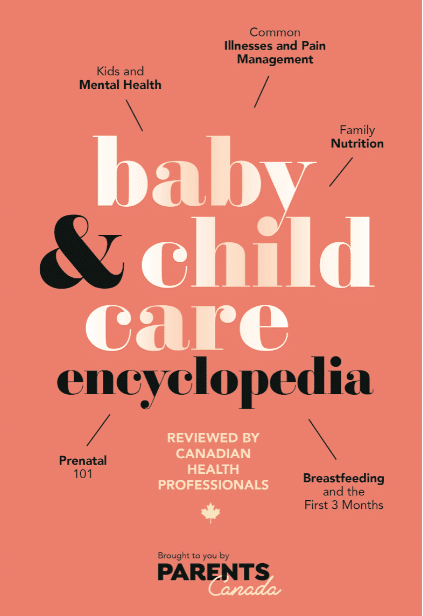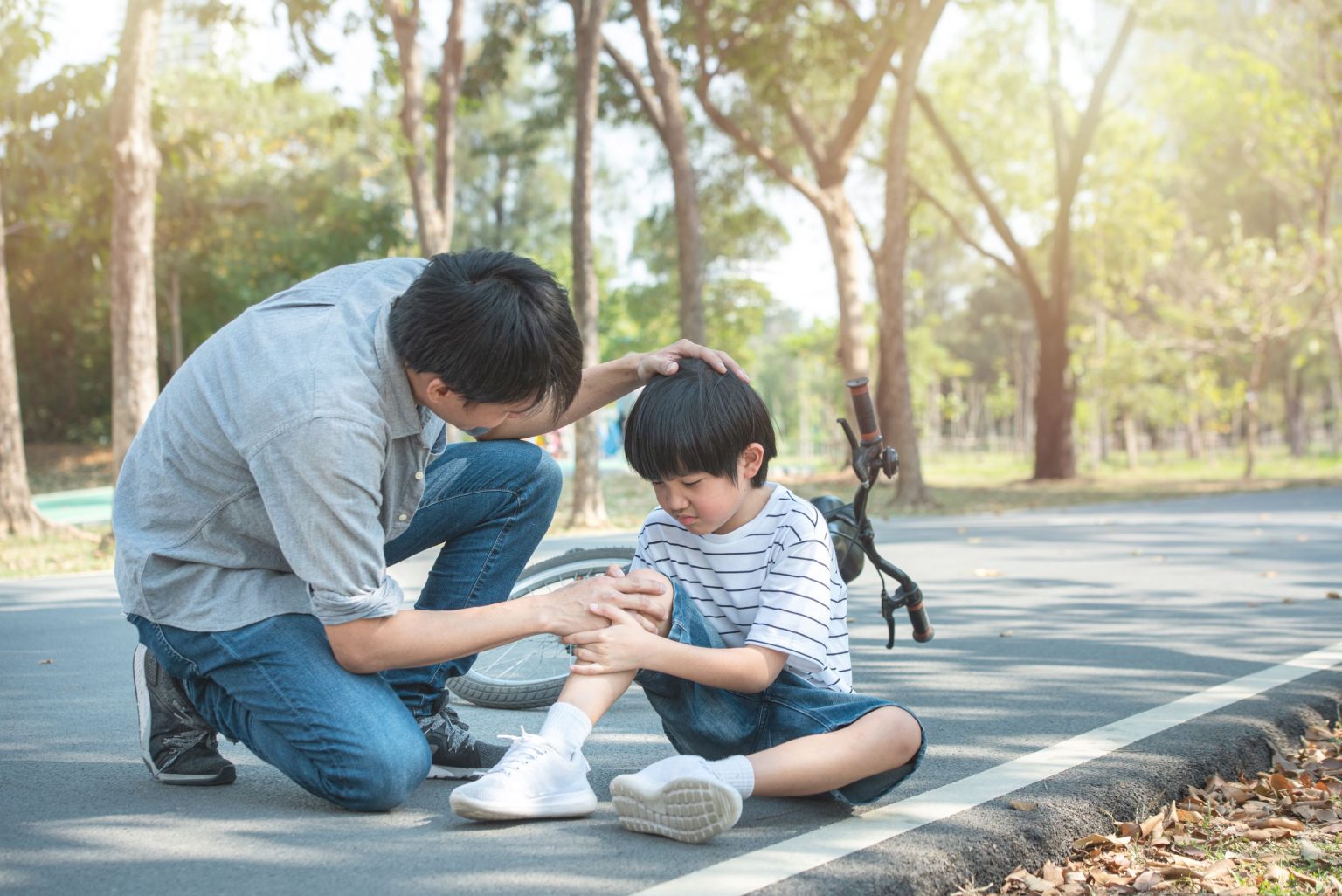 From the pages of the Baby & Child Care Encyclopedia: Chapter 8, Safety and First Aid
From the pages of the Baby & Child Care Encyclopedia: Chapter 8, Safety and First Aid
F rom insect bites to abrasions, we’ve got the goods on some of the common first aid emergencies you may face as a parent and how to handle them. Read on for what to watch for and how to look after your kiddo in each of the situations below.
Bites
Care
- Check the child’s ABCs (airway, breathing, circulation) immediately.
- Call EMS if there is severe bleeding or if the bite was caused by an unfamiliar animal.
- If the incident involved an animal, call your local animal control department. Give animal control the exact location of where the bite occurred.
- If the wound is minor, wash it with soap and water, control any bleeding and put a dressing on the wound.
- Watch for signs of infection. You might notice swelling, redness and warmth around the wound; pain or tenderness in the area of the wound; or pus or discharge. A more serious infection may cause fever or nausea.
- Human bites can easily become infected. Be especially careful to wash with soap and water and follow up by seeking medical attention.
Insect stings
Care
- Check the child’s ABCs (airway, breathing, circulation) immediately
- Remove the stinger by scraping it away from the skin
- Wash the area thoroughly with soap and water
- Apply a cold pack to help control swelling but put a thin cloth between the cold pack and skin to avoid freezing the skin. Keep it on for 20 minutes every hour
- Watch for signs of an allergic reaction. You might notice rash, itching or hives (raised, itchy areas of the skin); a feeling of tightness in the chest and throat; weakness, dizziness or confusion.
If the child develops an itchy rash, apply calamine lotion and cool compresses.
Ticks
Care
- Check the child’s ABCs (airway, breathing, circulation) immediately.
- If the tick hasn’t started to dig into the flesh, remove it by brushing it off the skin. If it has started to dig into the flesh, grasp its head with tweezers and pull it out.
- When the tick is out, wash the area with soap and water.
- Use an antibiotic ointment to prevent infections.
- If you cannot remove the tick, the child needs to see a doctor.
- If a rash or flu-like symptoms develop within a month of the tick bite, the child may have Lyme disease and requires medical attention immediately.
Lyme disease
Lyme disease is caused by a bite from an infected tick.
Early symptoms
- A rash in a small red area at the site of the bite that spreads up to 13 to 18 centimetres (5 to 7 inches) across.
- Fever, headache, weakness and joint and muscle pain that may feel like the flu.
Later symptoms (weeks or months after the bite)
- Arthritis, numbness or a stiff neck
- Memory loss
- Irregular or rapid heartbeat
- Problems seeing or hearing
- High fever
Bleeding, cuts and scrapes
Care
- Check the child’s ABCs (airway, breathing, circulation).
- Put on a pair of gloves. If gloves are not available, use another barrier between your hand and the wound. There is usually minimal bleeding with scrapes, but if there’s blood, put direct pressure on the wound until bleeding stops. If possible, have the injured child apply the direct pressure.
- Wash the wound thoroughly with soap and water.
- Blot the area dry with sterile gauze.
- Cover the wound with sterile non-stick dressing.
- Watch for signs of infection. If there is a great deal of dirt or contamination in the wound, seek medical attention.
If the blood soaks through the dressings, add more dressings on top. If you cannot control the bleeding, make sure the person gets medical attention immediately.
Broken bones
Bone, muscle and joint injuries are almost always painful. Without first aid, they can lead to serious injuries and even permanent disabilities. In some cases, they can be life-threatening.
Signs of a break include:
- Pain
- Deformity
- Swelling
- Bruising
- Limited use of, or an inability to move, the injured body part due to pain
- Broken bone or broken fragments sticking out of the skin or wound
- Sensation or sound of bones grading
- Possible muscle cramps
- Shock
- The sound of a snap or a pop when the injury happened
General care is the same for all bone, muscle or joint injuries. You do not need to know the specific injury.
Call EMS when:
- There is a problem with the ABCs.
- The injury involves the head and or neck.
- The injury makes walking difficult.
- You suspect that there may be more than one injury.
- There are injuries to the thigh bone or pelvis.
- The child has an altered level of consciousness.
Though you may not need to call 911 for a potential broken bone, a hospital visit is in order. Head to the emergency room for immediate diagnosis and treatment. The ER care team will advise you on follow-up care depending on the injury.
Chemical burns
- Ensure the child’s ABCs are present.
- Wear protective equipment and brush off excess dry chemicals.
- Flush with large amounts of cool running water for at least 15 minutes.
- Remove any clothing covered in chemicals from the child.
- Refer to the appropriate material safety data sheets (MSDS) or call your local poison control centre. Seek immediate medical attention.
Heat burns
This is any burn caused by overexposure to excessive heat, such as fire, steam and sun.
Care
- Ensure the child’s ABCs are present
- Cool the burn with running or standing water for at least 10 to 20 minutes. If the standing water becomes warm, add more cool water.
- Depending on the severity of the burn, you will decide on the course of treatment. Mild burns cause redness and swelling and can be treated at home, with an over-the-counter pain reliever, antibiotic ointment and vigilance for signs of infections. More severe burns may require emergency attention. A second-degree burn may blister in addition to causing pain, but if it’s a small burn, it can also be treated at home. A large second-degree burn may require further medical attention. Third-degree burns always require emergency medical care, such as calling 911, as they involve all levels of skin and fat. They may even involve muscle and bone. With third-degree burns, the injured may not feel pain because the nerve endings have been destroyed.
With all electrical burns, call for an ambulance and look for possible entry and exit burns that may need treatment. Carefully watch for breathing problems.
Electric shock
Do not touch the child until the power has been switched off.
Care
- Ensure the child’s ABCs are present. Electricity and lightning may affect the heart, so monitor the ABCs closely.
- Treat the child as if he or she has a head and/or spine injury. Stabilize the child’s head and neck by placing your hands on either side of the child’s head. Gently support the child’s head in the position in which you found it until EMS personnel arrive.
- If the child is wearing a helmet, leave it on unless it makes it difficult for you to ensure the child’s ABCs are present.
- Provide continual care until EMS personnel arrive.
- Look for two burns (an entry point and an exit point). They will be open wounds that need to be treated.
Hyperventilation
What to look for
- Uncontrolled gasping for air
- Dizziness
- Panic
- Anxiety
Care
- Ensure the child’s ABCs are present.
- Comfort the child. Encourage the child to take long, slow breaths and holds the breaths before breathing out slowly.
- Place the child in the recovery position so that blood can start flowing to the brain and the airways stays open. Then watch the child’s breathing closely.
- Provide continual care until EMS personnel arrive.
Inhaled poisons
What to look for
- Breathing difficulties
- Irritated eyes, nose, throat
- Dizziness
- Vomiting
- Seizures
- Unusual smell in the air
- Blueish colour around the mouth
- Unconsciousness
Care
- Ensure child’s ABCs are present.
- Call EMS and call your local poison control centre if the child has an altered level of consciousness or has difficulty breathing.
- Get the child into fresh air, but do not enter the hazardous atmosphere yourself to do so. Wait for EMS in this case.
- Provide continual care on the advice of medical professionals.
Absorbed poisons
What to look for
- Burns
- Rash
- Itching, burning
- Blisters
- Unconsciousness
- Swelling
- Hives (raised, itchy areas of skin)
Care
- Ensure the child’s ABCs are present.
- Remove the substance from the skin. Flush the skin with large amounts of water for at least 15 minutes. To prevent any further injury, make sure the water flushes away from any unaffected areas.
- Seek medical attention and provide continual care.
Ingested poisons
What to look for
- An open container of poison nearby
- Burns around the mouth
- Increase production of saliva and or saliva that isn’t abnormal colour
- Seizures
- Abdominal cramps and vomiting
- Dizziness and or drowsiness
- Unconsciousness
- Diarrhea
- A burning sensation in the mouth, throat or stomach
Care
- Ensure the child’s ABCs are present.
- Call your local poison control centre and take their advice. If advised, have someone drive you and the child to the hospital. Take the container or a sample of the poison in any vomit with the child to the hospital. If the child has an altered level of consciousness or difficulty breathing, call 911.
NOTE Never induce vomiting if the child is unconscious, having seizures or has swallowed a corrosive or petroleum product. Give water or milk or induce vomiting only if directed to by EMS or the poison control centre.
Read more from the Baby & Child Care Encyclopedia.
-
-
- Prenatal 101
- Breastfeeding and the First Three Months
- Starting Solids and the Toddler Years
- An Age-by-Age Guide to Sleep
- Family Nutrition
- Kids and Mental Health
- When Your Child is Sick
- Safety and First Aid
- Milestones, Checklists and Charts
-


















